This week the old car that drew my attention on the Finding Future Classic Cars group was this silver over red 1986 Cimarron available in Middletown, CT for a mere three grand. Yep. A Cimarron. And I like them. So buckle up.
Yes, yes, the Cimarron. That low-hanging fruit for cantankerous coots. Yes, it was the smallest Cadillac in decades, perhaps the smallest ever. It was also the first in decades with a stick shift. Available with either the standard 2.0 four (shades of 2021) or optional 2.8L V6, it was meant as an ‘importy’ choice for sporty Cadillac buyers who might have been eyeing certain BMW, Ovlov or Mercedes saloons.
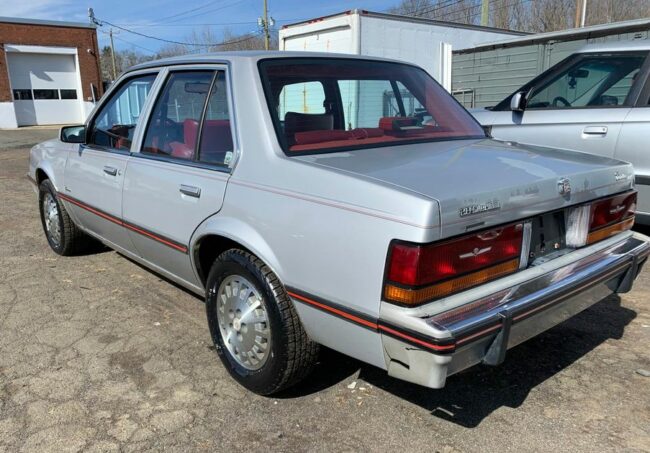
By ’86 the car was much better looking, with a new nose with flush headlamps, new, more Cadillac-like grille and larger taillamps. The 2.0 four produced 88hp at 4800 rpm; the V6, 129 also at 4800 rpm.

An ’87 BMW 528e produced 121, by the way, though the 535i and 535is were much more lively. And I doubt anyone cross shopped the two!
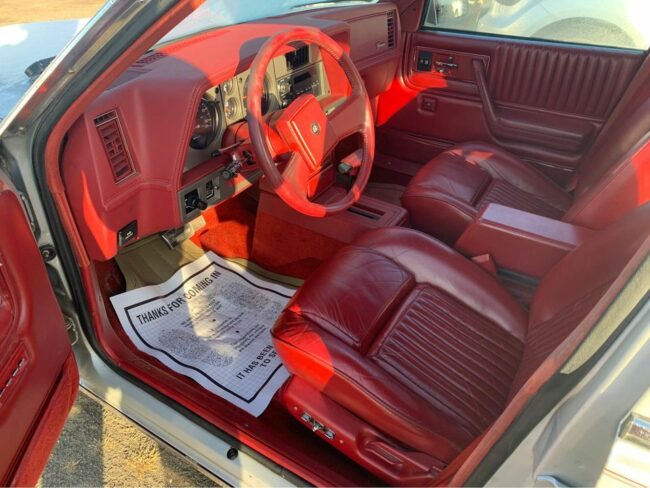
One thing that gets conveniently omitted on the many bilious posts on Cimarrons is that Cadillac really didn’t want a J-car variant. But the dealers leaned on Cadillac to the extent that they finally said, fine. We’ll build the damn thing.
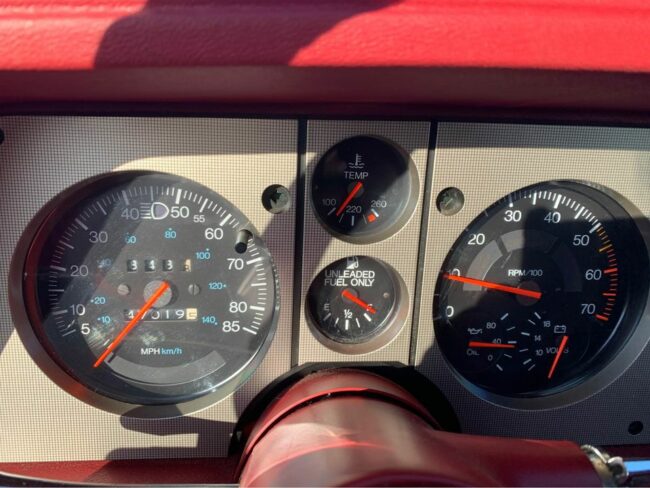
Now, Cadillac Division could have told the dealers to pound sand, but many were threatening to abandon their franchise if they didn’t get the J-Caddy. (UPDATE: It wasn’t their threatening to abandon their Cadillac franchise, they were threatening to add a foreign marque to their dealerships, which Cadillac did not want at all. Thanks Carmine, it’s been some time since I read the Automobile Quarterly Cadillac history.)
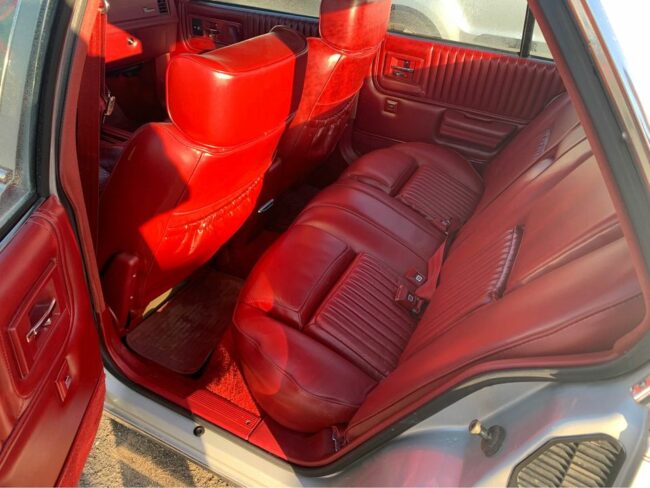
So it went into production. And recall the early ’80s were a pretty screwed up time, not just for the General, but for the entire car market.
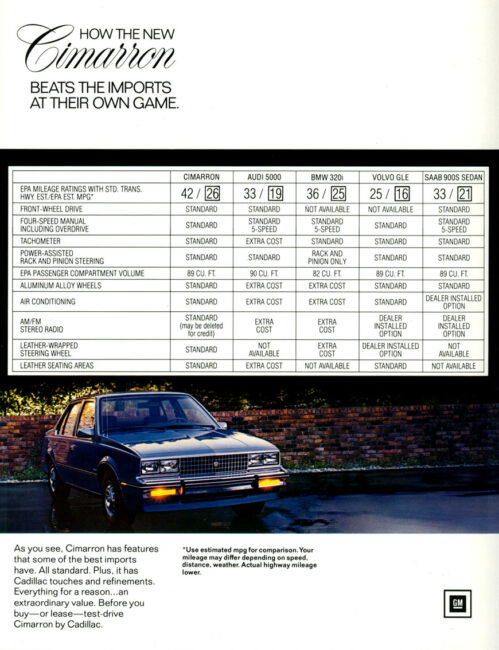
All the downsizing, all the inflation, all the worry about gas prices, CAFE, you name it. And it was in the middle of all this crazy crap that the Cimmy was born. It was a different time.
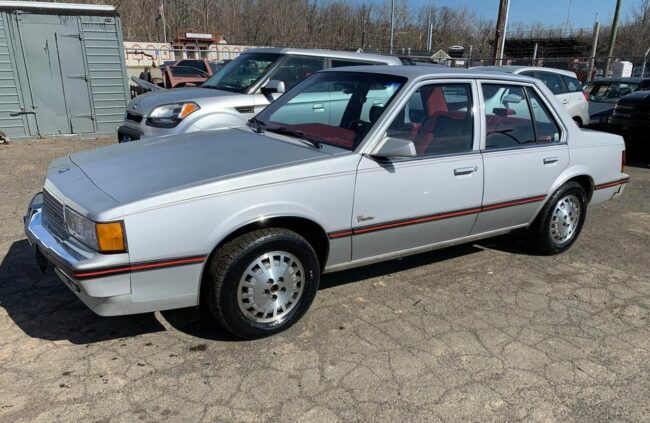
So anyway, I like them. It’s probably due to my seeing a brand new one at the 1988 Chicago Auto Show.
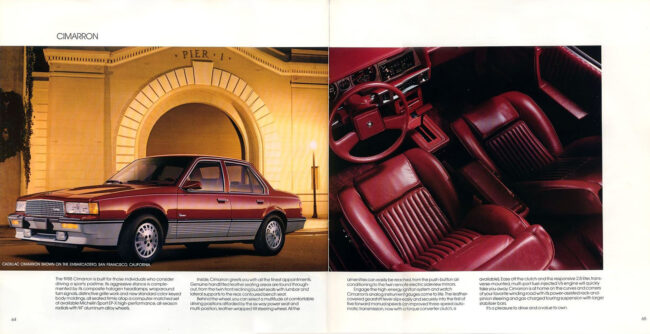
Burgundy with silver cladding and burgundy leather, it just appealed to me-I was an impressionable second grader at the time. I wanted to sit in it, but it was one of the few cars locked. Under the wiper was a note: Car sold. So that was that. But I still remember it, thirty odd years later. The great colors, the nice size, the attractive alloys.
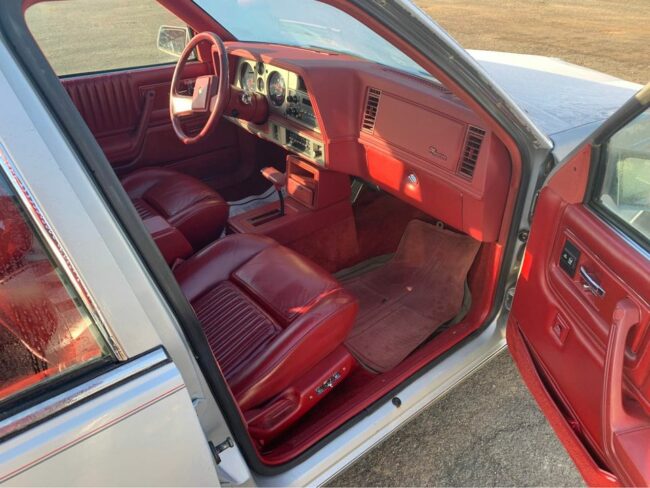
As for the featured car, per the seller: “Up for sale is a 1986 Cadillac Cimarron, runs and drives great. 1 owner only 47,000 miles interior is very clean, no rips in seats, there is no rust on the car, asking $3,000 OBO.” For three grand it looks nice. If it was closer I might do something stupid. I think it’s that amazing cherry-red leather. I miss real interior colors.
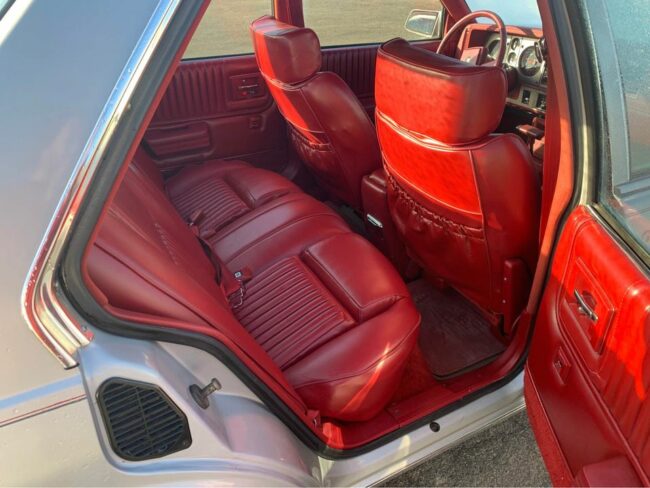
And yes, I get why the car has had plenty of internet warriors heaping scorn on it. But, I love ’em, especially the 87-88s with the baby Sedan de Ville nose and cladding. And the V6 of course. Lexus loved them too, just look at the original ES250. Bwahahahahaha!
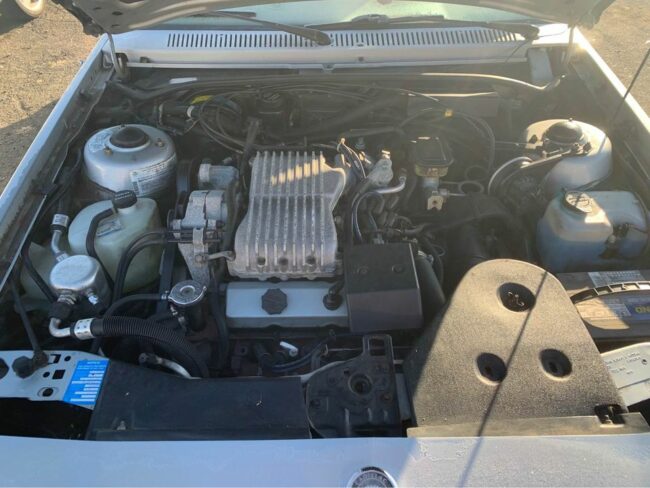
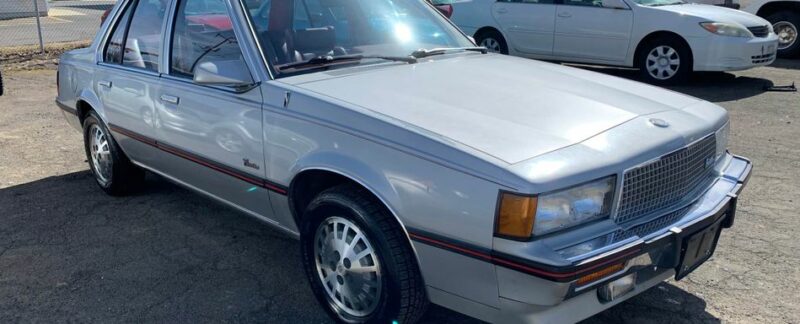

It’s funny, looking at them now, 3rd grade me was more impressed…. They did also look better with the aforementioned bodying cladding. $3k for a low mile car with a red interior though? Color me intrigued.
A V6 Cimarron isn’t a very nice Cadillac, but it’s a very nice Cavalier. $3K with less than 50K miles is a good buy, too. I bet they’d be asking more for a ’86 Z24 with the same miles and condition.
While Cadillac deserves every bit of criticism it received, Cimarron remains the Rodney Dangerfield of automobiles: It gets no respect.
I never drove one. But I found them attractive. Especially in d’Oro trim.
In 1987 when I was shopping for my first new car, my Cadillac dealership didn’t carry them. They had no brochures. And nobody wanted to talk about them. I crossed town and ended up ordering a Caprice with the 9C1 package. Unarguably the better car. Yet even today, Cimarron remains for me one of those unrealized conquests of a young man.
Tell the fan boys of these cars (They do exist) that this “Caddy” is the pig wearing lipstick.
“Nooooooo, it’s not a Chevy with different suspension tuning. Noooooooooo”.
Hemmings Classic Car mag letters to the editor from 2017 I believe.
This dolled up Chevy looks real nice.
That’s actually correct; what it IS, is a chevy with leather seats.
If this had been the version Cadillac started with at launch there would have been no jokes about the Cimarron. FI V-6, 5 speed availability, nice leather interior and alloy wheels, a few styling mods to make it look more like a Caddy and less like a Cavalier – there is no reason GM couldn’t have done this at launch, but no they wait until the reputation is ruined and then perfect the car just before they terminate it due to lack of sales.
The first generation Seville and last real Nova that Tom has featured in recent days offers an interesting analogy. Imagine the reputation of those first Seville’s if Cadillac had merely put some Caddy badges on a Nova, offered the Chevy inline 6 as the only motor choice, made the Nova gauge package and LN level interior standard, and then doubled the Nova’s price. If GM had done that in 1975 we would be talking about the Seville in the same way we talk about the Cimarron – as the car that destroyed Cadillac’s reputation.
This car might have cut it in 1982, but the earth was moving fast under its feet. By 1986, the E21 320i had been replaced by the E30, which finally gave BMW modern levels of HVAC and an ergonomic radio installation simultaneously. Engine development was rapidly catching up with emissions regulations, so even good four cylinder cars were reasonably powerful and refined.
Gas was cheap again, so nobody wanted a premium small car that was merely small and expensive. It wasn’t enough for the Cimarron to no longer be slower than a city bus. It had to sell in a world with the Acura Integra, the Ford Taurus, the third generation Honda Accord, and the Nissan Maxima. Those cars were all much nicer to drive, never mind a 325ES or 300E.
All true CJ, but this Cimarron in 1982 and on through 1988 with some refinements would have made a lot of Cadillac loyalists looking for a wife’s car happy rather than quickly sending them to the local Honda dealer for a fancy Accord.
The engine used in the Cimarron at introduction wasn’t the 2.0 liter pushrod four. It was a 1.8 liter version of the little pushrod four. Acceleration times were glacial, comparable only to diesels. All of the J-cars were overweight on arrival, and the 2.0 was rushed into production because they showed up being exceptionally underpowered at a time when few small cars were adequately powered.
Cadillac first topped 200,000 sales in 1968. In 1985, Cadillac sold almost 300,000 cars. I find it hard to believe that dealers were threatening to drop franchises over the lack of a J-car in 1981. The DeVilles were flying high sales-wise, and the Oldsmobile diesel engines seemed to point to a solution to CAFE for big luxury cars. In 1990, Cadillac started a pattern of hemorrhaging market share year after year, but nobody on the retail side of the business in 1980 was looking out far enough to see the ruination to come. The success of the first Seville was recent history, and the downsized Eldorado was very well received. Why would they have threatened to leave over the lack of a car that wasn’t what their customers or import customers wanted?
It wasn’t dropping franchises, it was about “dualing” franchises, GM didn’t want it’s Cadillac dealers adding a foreign franchise, they wanted to avoid their flagship car line sharing showroom space with BMW’s or Saabs etc.
Cadillac basically got involved in the J-car in 1980 and the Cimarron launched summer 1981. The Seville at least had a few years of development from late 1972-1974, I would have liked to have seen what a full baked Cimarron would have been, probably closer to the better 1985-1988 versions.
I remember talking to a dealer at the time of the Cimarron introduction who told me they had to be pulled out of the auto-carriers when they were tucked in the low spot between the trailer axles because they didn’t have enough power to get over the hump and drive off. Just what a Cadillac owner wanted – a pushrod 4 with zero refinement and negative HP.
“and negative HP.”
The V6 should have been standard on the Cimarron but it isn’t like base car was the only weak-power Cadillac in 1982.
Certainly true – there were a lot of disappointed Cadillac shoppers in 1982. Imagine coming in to trade a 1978 DeVille with a nice reliable and smooth 180 hp 425 cubic inch V-8 and being confronted with the choice of a 4.1 liter V-8 with 125 hp, or a 5.7 liter diesel with 105 hp, or a Cimarron with a 1.8 liter and a blazing 88 hp.
The Cimarron may have been the hot-rod of Cadillac’s lineup in 1982!
There might still be a few stuck on auto carriers somewhere….
I hear they were so slow that they actually went back in time and this poor kid from California had to go back in time with a Cimarron to make sure his parents hooked up at the Fish Under the Sea Dance….
I heard they actually had negative hp ratings…..
Any more bullshit anyone wants to make up?
Since we’re wildly and dramatically talking about how slow the Cimarron was, allegedly there is still someone trying to get to 60mph in 1982 and he still hasn’t gotten there….
Lets post some real numbers……
82 Cimmy
0-60 13.7
1/4 19.5@70mph
Flat out 91mph
Volvo 240GL
0-60 10.9
1/4 17.8 @75mph
Flat out 99mph
Accord SE
0-60 13.7
1/4 19.1 @69mph
Flat out 92mph
Audi 4000
0-60 13.3
1/4 18.7@ 71mph
Flat out 93mph
BMW 320i
0-60 10.4
1/4 17.5@ 76mph
Flat out 101mph
The 320i was clearly the 426 Hemi of this 3 legged dog race….I’m wondering how any of these cars got off the car carrier.
I have the November, 1981 Road & Track test of the Cimarron 1.8L/4-speed in front of me. The comparison vehicles were the BMW 320i 1.8L/5-speed and the Honda Accord 4-door 1,751cc/5-speed.
82 Cimarron
0-60 15.9
1/4 20.3@68mph
22 MPG
BMW 320i
0-60 11.1
1/4 18.0@ 77mph
26 MPG
Accord 4-door
0-60 13.4
1/4 19.2 @69.5mph
24.5 MPG
The real problem was found on page 134 of the same issue. Honda had a new Accord ready to reset the bar, bigger in every dimension than the old one while being 70 pounds lighter and blessed with five years of R&D from making the one that GM was almost ready to match in some ways. In the US, GM basically folded on the segment right then. They’d be selling variants of the uncompetitive-at-birth J-car in the US when the Accord was in its seventh generation as a semi-premium midsized car. In Europe the J-car followed a similar path to our Accord, with the Ascona growing into the Vectras and then the Insiginia, a car you might recognize as a recent Buick Regal. Why didn’t GM take the US market as seriously as they took Europe? Sure, midsized and compact cars are doing some tough sledding these days. Only after Toyota, Honda and Nissan sold millions in the void left by GM, Ford and Chrysler throwing in the towel.
I think that if Cadillac had to eat the shit sandwich that was the Cimarron they should have gone all the way, offered all the body styles, wagon, coupe, hatch, the later convertible, similar to how the 3 series expanded over the 80’s and then continued to develop it, there was almost a “2nd gen” Cimarron that considered and axed when the J-cars were mid-updated around 88-89 , it would have carried styling similar to the 92 Seville.
Either that or use the X-car and develop a proper “Seville X-car” with the V6 and more development cash.
The X-car was damaged goods by the time the Cimarron showed up, but the A-bodies benefited from enough X-car development to not have been emblazed with a giant lemon. I recently saw a Cutlass Cierra with a leather interior nicer than the fabric one in the Cutlass Ciera GT a friend of my sister received for her 16th birthday. By combining the Oldsmobile dashboard with Cadillac-appropriate door-trim and seating; Pontiac 6000STE chassis tuning; and whatever their best drivetrain of the moment was: GM could have made a very pleasant mid-sized Cadillac. Gas prices were falling as supply stabilized though, and I think it was Car and Driver that photographed a row of A-bodies from an elevation; revealing that they were made with the same cookie-cutter. Cadillac would have needed some distinctive bodywork that went front and rear facias to avoid joining the punchline. That being said, CAFE should have given them the motivation to try making a good alternative to the Audi 5000S and Volvo 740, but it didn’t.
The difference is that the Volvo, Audi, and BMW didn’t sound like they were going to explode while running those quarter miles, and they also didn’t start falling apart at 15,000 miles.
We test drove a new Cimarron back in 1985 or so when I was 5 or 6 years old. My parents complained on the way home that they couldn’t really afford it.
My dad ended up buying a 1979 Mercedes 240D that had been in an accident and repaired badly. It has zero options – manual transmission, vinyl seats, crank windows, etc. My dad explained that this was basically a European taxi and would be much more reliable than the Pinto it was replacing – or any American car for that matter. For once, the old man was right! He kept it for many years and 250k+ miles. It’s still the slowest car I’ve ever ridden in.
The 240D – one of the few cars that made a Cimarron seem like a rocket ship, but they certainly could rack up the miles.
Did he get a good deal on the 240D because it was still stuck on the car carrier?
A 3500lb car with 4hp should be really hard to get off the truck……
My 1982 Mercedes 240D with slushbox (the *only* option, not even a radio) is still going strong at 32X,XXX miles, doesn’t smoke nor leak oil .
It’s aggravating trying to merge into freeway traffic at 45 ~ 50 MPH though .
I’d prolly be killed driving it in TEXAS .
They didn’t have Vinyl, they had MB-TEX that looks like leather but doesn’t wear out .
-Nate
What really doomed the Cimarron from the start was probably the fact that GM put the Chevy/Pontiac dash in the thing, along with rushing it out with the Cavalier and J2000. If they would have waited a year, and released it with the Olds/Buick dash with a few extra touches, a few more unique styling touches, and at least offered the Brazilian 1.8 OHC-FI from the get-go, along with the other 1983 J-car improvements, the Cimarron might’ve been the butt of fewer jokes. IDK (or don’t remember) if there was a five-speed stick available with the V6, but that combo (or a Cadillac-exclusive 4OD automatic) would have put the Cimarron at least a little above the more pedestrian fare in the other divisions. My 1984 Pontiac Sunbird hatchback was reasonably pleasant, and the same platform with a THM-425C and the injected V6, while not a BMW-fighter, wouldn’t have been that bad of a sled! Sort of the way an Acura isn’t horrible if you don’t expect anything more than an Accord+.
Unfortunately, all we ended up with was a Cavalier with Twilight Sentinel and leather seats. And another GM epic failure!
It really looks like a UK Vauxhall Cavalier Mk2 (which was a superb car and didn’t pretend to be a luxury item)
You may remember that when your UK Cav was current there was a Ford competitor called the Orion, which was a Sierra sedan. At the time, in the USA we got a sporty version sold through Mercury instead of Lincoln. It was priced in 1988 $3000 higher than Cimarron plus $800 more if you wanted one color, sorry colour, leather. In a reverse from Europe, where your Cav was 4 only and the sporty Sierras had a V6, ours had a turbo 4 and at the end the Cimarron were all V6. Ironically the chanters above all love that Mercury as the Hymnal decrees.
The Ford Orion was an Escort with a trunk, not a Sierra sedan.
The Merkur XR4ti was a turbocharged Ford, and therefore started out with two major strikes. It was also basically rejected by the market and often ridiculed for Ford’s dumb marketing and its biplane rear spoiler. That being said, it had some important distinguishing characteristics relative to the Cimarron. The turbocharged four cylinder engine was making 175 horsepower in 1988, while the Cimarron’s V6 fell from 130 to 125 horsepower after 1986. The Merkur was an expensive car because it was expensive to bring to market. The body-style chosen with three windows on each side had only been offered on the limited-production Sierra XR4i from 1983-1985, meaning that it was being kept in production solely for the Merkur XR4ti. Then there was the cost of federalizing the body for US sale, since the European nanny-state and its safety standards still lied in the future. There were also the logistical expenses involved in powering it with a Brazilian engine that could pass US emissions standards while producing competitive power with other pricey imports. The Cimarron was only expensive to differentiate it from the hundreds of thousands of hair-shirt economy cars it was otherwise the same as. The Merkur was stupid. The Cimarron was a cynical POS meant to prey on people who spent money the way you think they should have been obligated to.
Give me that old time religion
Give me that old time religion
Give me that old time religion
It’s good enough for me
Wait, I think I picked up the wrong hymnal….these guys are all singing the same song and it is not this one. Screw it, this one is better. Where was I?
It was good for the Hebrew children
It was good for the Hebrew children
It was good for the Hebrew children
And its good enough for me
Thanks for bringing this car to us Tom, and you were right that Paul’s Hymnal was going to mean the chant backs in the comment section were going to be a ride for you. It was instructive how they had to go back to the 81 because Paul was not one to keep up with updates on domestics.
I can very much identify with you at the car show imagining yourself as the young man about town in the style of your father and grandfather before you in a car like the Cimarron. That table that was in the early Cimarron ad you showed told it all. I had remembered. the dealer installed teeth pulling being a Honda disease, but look how much it also affected the Euros. A man who is just trying to buy a car is going to come out of the import dealer feeling like a rent boy at a convention of democratic mayors. No wonder those cars became so associated with lease deals for barrow boys.
“What’s THIS?”
“An intelligence test.”
One that people are still failing, by doing things like buying $100,000 Chevy pickups because they say “Escalade”.
The Escalade is a good buy and a good deal.
For $100k you get everything you get in an $80k Tahoe (or $75k Silverado) plus nicer interior, more gadgets, more style, and more comfort. When you go to sell it, you’ll get most of that differential back.
The same goes for the Navigator. It’s hard to call a $100k vehicle a bargain but look what it gets you from the Germans.
It’s still a $100,000 Chevy 1500 with sheet metal over the back, more seats, leather upholstery, and a bunch of electronics that probably cost all of $30 manufacturing cost.
Oh yeah I forgot all the “gold” vacuum-metallized polystyrene trim to make you feel like it’s “lugzhury”.
I think we’re going to have to agree to disagree here; I own a loaded-up Silverado LTZ and when I drive the new Escalade I see a lot of clear air between what I have and it is.
Now, if you want to argue that a GMT800 Escalade isn’t worth a penny over a Silverado, you’ll get no argument from me. It wasn’t and isn’t. The last two generations have been different in that regard.
Damn ;
Yet another epic GM failure I find pleasing to look at….
I liked my ’81 Chevy Citation too, then I drove it and it began breaking down….
-Nate
Well, as a $6000 Cavalier, cheap and cheerful, expecting it to rattle and squeak from the get-go, all the plastic interior bits to get brittle after 5 years, but always carry you down the road, it was OK-ish. As a Cadillac it proved that a lot of people are not very bright or well-informed. I had a Cavalier for a year; from about 15,000 to about 30,000 miles. It never failed to get me where I needed to go. I can’t say much more positive about it. I will note that over the year I had it, three of the four stereo speakers quit working – I don’t remember any actual failures other than that. If your “Standard of Excellence” is calibrated to “Soviet Union, 1960” then I suppose you could argue yourself into buying this as a Cadillac…
Don’t worry JC, the Cimarron had a better stereo than a Cav. Many had the Delco GM Bose system in fact. I am not sure everyone out there is going to agree with you that desiring beyond basic and being willing to spend, not borrow, spend to get it is the definition of low IQ.
I am glad the one speaker kept working for you. You cheap and cheerful folks learn quickly to get by with just what you need and no more.
The specs of the Cimarron stereo were probably better, but I bet it was the same buffoons on the line half-making the connections.
The door panels were probably covered in nicer stuff, but if the same plastic clips and nails were used, they would start rattling at the same time.
I don’t know if Cavaliers were rustbuckets, but if they were, the Cimarrons were going to rust through in the same places at the same times.
They rusted terribly around the front upper strut mounts. I saw many cobbled repairs back then.
>>Lexus loved them too, just look at the original ES250. Bwahahahahaha!<<
I think Lexus stole that from the Legend – the early ones
https://static.cargurus.com/images/site/2017/02/13/20/27/1986_acura_legend_base-pic-4630952904393023841-1600×1200.jpeg
I guess I still have some Cadillac love deep inside my, because even the Cimarron pulls at the heartstrings just a touch. I’ve thought a late production 5 speed, with the V6 would be great fun.